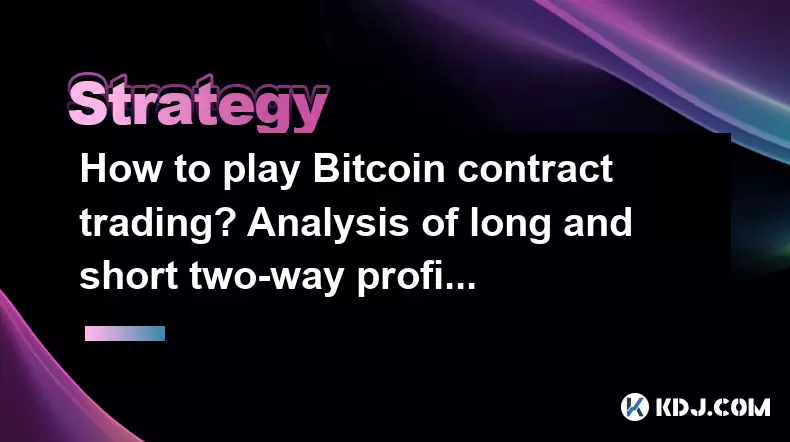-
 bitcoin
bitcoin $122090.672462 USD
1.59% -
 ethereum
ethereum $4493.758974 USD
0.56% -
 xrp
xrp $3.033145 USD
0.65% -
 tether
tether $1.000629 USD
0.00% -
 bnb
bnb $1169.854250 USD
7.07% -
 solana
solana $230.954786 USD
-0.19% -
 usd-coin
usd-coin $0.999785 USD
0.00% -
 dogecoin
dogecoin $0.256108 USD
-1.12% -
 tron
tron $0.342333 USD
-0.12% -
 cardano
cardano $0.859632 USD
-0.10% -
 hyperliquid
hyperliquid $48.932146 USD
-2.25% -
 chainlink
chainlink $22.345466 USD
-1.29% -
 ethena-usde
ethena-usde $1.000217 USD
-0.03% -
 avalanche
avalanche $31.203456 USD
1.93% -
 sui
sui $3.579145 USD
1.05%
How to play Bitcoin contract trading? Analysis of long and short two-way profit strategies
Bitcoin contract trading allows speculation on price movements without owning the asset, using long and short strategies to potentially increase profitability.
May 30, 2025 at 10:49 am

Bitcoin contract trading has become an increasingly popular way for cryptocurrency enthusiasts to engage in the market without needing to own the underlying asset. This article will delve into the mechanics of playing Bitcoin contract trading, focusing on the analysis of long and short two-way profit strategies. Understanding these strategies can help traders make informed decisions and potentially increase their profitability.
Understanding Bitcoin Contract Trading
Bitcoin contract trading involves trading contracts that represent an agreement to buy or sell Bitcoin at a future date at a predetermined price. These contracts are derivatives and do not require the trader to own the actual Bitcoin. Instead, traders speculate on the future price movements of Bitcoin to make profits.
There are two primary types of Bitcoin contracts: futures and options. Futures contracts obligate the buyer to purchase and the seller to sell the asset at the specified future date and price. Options contracts, on the other hand, give the buyer the right, but not the obligation, to buy or sell the asset at the specified price before the expiration date.
Long Position Strategy in Bitcoin Contract Trading
A long position in Bitcoin contract trading is taken when a trader expects the price of Bitcoin to rise. By entering a long position, the trader buys a contract with the anticipation that they can sell it at a higher price in the future.
To execute a long position in Bitcoin contract trading, follow these steps:
- Choose a reputable trading platform: Ensure the platform supports Bitcoin futures or options trading and has a good reputation for security and reliability.
- Open an account: Register and complete the necessary verification processes to comply with the platform's KYC (Know Your Customer) requirements.
- Deposit funds: Fund your account with the required amount to trade Bitcoin contracts.
- Select a contract: Choose the Bitcoin futures or options contract that aligns with your trading strategy and risk tolerance.
- Enter a long position: Place a buy order for the selected contract. Monitor the market closely to decide when to close the position.
- Close the position: Sell the contract when the price of Bitcoin has risen to your target level, realizing a profit.
Short Position Strategy in Bitcoin Contract Trading
A short position in Bitcoin contract trading is taken when a trader expects the price of Bitcoin to fall. By entering a short position, the trader sells a contract with the anticipation that they can buy it back at a lower price in the future.
To execute a short position in Bitcoin contract trading, follow these steps:
- Choose a reputable trading platform: As with long positions, ensure the platform is secure and reliable.
- Open an account: Register and complete the necessary verification processes.
- Deposit funds: Ensure your account has sufficient funds to cover the margin requirements for short selling.
- Select a contract: Choose the Bitcoin futures or options contract that fits your trading strategy.
- Enter a short position: Place a sell order for the selected contract. Keep a close eye on market trends to determine when to close the position.
- Close the position: Buy back the contract when the price of Bitcoin has fallen to your target level, realizing a profit.
Risk Management in Bitcoin Contract Trading
Risk management is crucial in Bitcoin contract trading to protect against potential losses. Here are some key strategies to manage risk:
- Use stop-loss orders: Set stop-loss orders to automatically close your position if the market moves against you beyond a certain threshold.
- Diversify your portfolio: Do not put all your capital into one type of contract or one position. Spread your investments to mitigate risk.
- Understand leverage: Be cautious with leverage, as it can amplify both gains and losses. Use it judiciously and only with a clear understanding of the risks involved.
- Stay informed: Keep up-to-date with market news and trends that could affect Bitcoin's price. Use this information to make informed trading decisions.
Technical and Fundamental Analysis for Bitcoin Contract Trading
Successful Bitcoin contract trading often involves a combination of technical and fundamental analysis. Technical analysis involves studying historical price data and market statistics to identify patterns and trends. Fundamental analysis, on the other hand, looks at broader economic and market factors that could influence Bitcoin's price.
For technical analysis, traders might use tools such as moving averages, RSI (Relative Strength Index), and chart patterns to predict future price movements. For fundamental analysis, consider factors such as Bitcoin's adoption rate, regulatory news, and macroeconomic trends.
Combining Long and Short Strategies for Profit
Combining long and short strategies can provide a balanced approach to Bitcoin contract trading. By simultaneously holding long and short positions, traders can hedge their bets and potentially profit from market volatility in both directions.
To implement a combined long and short strategy:
- Identify market trends: Use technical and fundamental analysis to understand the current market direction.
- Open long and short positions: Based on your analysis, enter a long position if you expect the price to rise and a short position if you expect it to fall.
- Monitor and adjust: Continuously monitor the market and adjust your positions as needed. If the market moves in favor of your long position, you might close the short position to maximize profits.
- Profit from volatility: By holding both long and short positions, you can profit from market swings in either direction, provided you manage your positions effectively.
Frequently Asked Questions
Q: What are the main differences between futures and options in Bitcoin contract trading?A: Futures contracts obligate both the buyer and seller to fulfill the contract at the specified future date and price. Options contracts give the buyer the right, but not the obligation, to buy or sell the asset at the specified price before the expiration date. This flexibility makes options potentially less risky but also limits potential profits compared to futures.
Q: Can I trade Bitcoin contracts on any cryptocurrency exchange?A: Not all cryptocurrency exchanges offer Bitcoin contract trading. You need to choose a platform that specifically supports futures or options trading for Bitcoin. Examples include Binance, Bybit, and BitMEX.
Q: How does leverage affect Bitcoin contract trading?A: Leverage allows traders to control a larger position with a smaller amount of capital. While it can amplify profits, it also increases the potential for significant losses. It's important to use leverage cautiously and understand the margin requirements and potential liquidation risks.
Q: What are the tax implications of Bitcoin contract trading?A: The tax implications of Bitcoin contract trading vary by jurisdiction. In many countries, profits from trading are subject to capital gains tax. It's advisable to consult with a tax professional to understand the specific regulations and reporting requirements in your area.
Disclaimer:info@kdj.com
The information provided is not trading advice. kdj.com does not assume any responsibility for any investments made based on the information provided in this article. Cryptocurrencies are highly volatile and it is highly recommended that you invest with caution after thorough research!
If you believe that the content used on this website infringes your copyright, please contact us immediately (info@kdj.com) and we will delete it promptly.
- BlockDAG, DOGE, HYPE Sponsorship: Crypto Trends Shaping 2025
- 2025-10-01 00:25:13
- Deutsche Börse and Circle: A StableCoin Adoption Powerhouse in Europe
- 2025-10-01 00:25:13
- BlockDAG's Presale Buzz: Is It the Crypto to Watch in October 2025?
- 2025-10-01 00:30:13
- Bitcoin, Crypto, and IQ: When Genius Meets Digital Gold?
- 2025-10-01 00:30:13
- Stablecoins, American Innovation, and Wallet Tokens: The Next Frontier
- 2025-10-01 00:35:12
- NBU, Coins, and Crypto in Ukraine: A New Yorker's Take
- 2025-10-01 00:45:14
Related knowledge

Practical parameter settings for a Bitcoin multi-timeframe moving average system
Sep 18,2025 at 10:54pm
Optimizing Timeframe Combinations for Bitcoin Trading1. Selecting appropriate timeframes is crucial when building a multi-timeframe moving average sys...

How can I filter out false breakouts in Dogecoin high-frequency trading?
Sep 22,2025 at 01:00am
Understanding False Breakouts in Dogecoin Trading1. A false breakout occurs when Dogecoin's price appears to move beyond a defined support or resistan...

Techniques for identifying tops and bottoms in the Bitcoin on-chain NVT model
Sep 20,2025 at 07:54pm
Understanding the NVT Model in Bitcoin Analysis1. The Network Value to Transactions (NVT) ratio is often described as the 'P/E ratio' of the cryptocur...

What does the surge in open interest in Bitcoincoin futures mean?
Sep 20,2025 at 11:18pm
Understanding the Surge in Dogecoin Futures Open Interest1. A surge in open interest within Dogecoin futures indicates a growing number of active cont...

How can I use the Ethereum USDT premium to gauge market sentiment?
Sep 18,2025 at 11:55pm
Understanding the Ethereum USDT Premium1. The Ethereum USDT premium refers to the price difference between USDT (Tether) traded on Ethereum-based plat...

What should I do if Ethereum staking yields decline?
Sep 20,2025 at 06:18am
Understanding the Causes Behind Declining Ethereum Staking Yields1. The Ethereum network transitioned to a proof-of-stake consensus mechanism with the...

Practical parameter settings for a Bitcoin multi-timeframe moving average system
Sep 18,2025 at 10:54pm
Optimizing Timeframe Combinations for Bitcoin Trading1. Selecting appropriate timeframes is crucial when building a multi-timeframe moving average sys...

How can I filter out false breakouts in Dogecoin high-frequency trading?
Sep 22,2025 at 01:00am
Understanding False Breakouts in Dogecoin Trading1. A false breakout occurs when Dogecoin's price appears to move beyond a defined support or resistan...

Techniques for identifying tops and bottoms in the Bitcoin on-chain NVT model
Sep 20,2025 at 07:54pm
Understanding the NVT Model in Bitcoin Analysis1. The Network Value to Transactions (NVT) ratio is often described as the 'P/E ratio' of the cryptocur...

What does the surge in open interest in Bitcoincoin futures mean?
Sep 20,2025 at 11:18pm
Understanding the Surge in Dogecoin Futures Open Interest1. A surge in open interest within Dogecoin futures indicates a growing number of active cont...

How can I use the Ethereum USDT premium to gauge market sentiment?
Sep 18,2025 at 11:55pm
Understanding the Ethereum USDT Premium1. The Ethereum USDT premium refers to the price difference between USDT (Tether) traded on Ethereum-based plat...

What should I do if Ethereum staking yields decline?
Sep 20,2025 at 06:18am
Understanding the Causes Behind Declining Ethereum Staking Yields1. The Ethereum network transitioned to a proof-of-stake consensus mechanism with the...
See all articles










































































